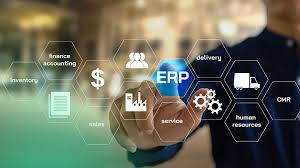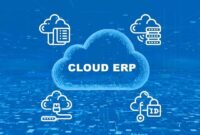In today’s fast-paced business environment, companies need to optimize their operations to stay competitive. Implementing enterprise resource planning software can help streamline processes, improve efficiency, and reduce costs.

By integrating various functions into a single system, erp solutions provide a unified view of business operations, enabling better decision-making and improved productivity. With robust ERP systems, organizations can automate tasks, enhance collaboration, and drive growth.
The benefits of implementing enterprise resource planning software include enhanced visibility, improved compliance, and reduced operational costs. By streamlining operations, businesses can focus on strategic initiatives and drive long-term success.
What Are ERP Solutions and Why Do They Matter?
ERP systems are designed to integrate various business functions into a single, unified platform, providing real-time insights and enhancing decision-making. This integration enables organizations to streamline their operations, improve efficiency, and reduce costs.
Definition and Core Functionality
At its core, an ERP system is a comprehensive software solution that automates and manages business processes across different departments, including finance, human resources, supply chain, and customer relationship management. By providing a centralized database and real-time data analytics, ERP systems enable businesses to make informed decisions, optimize resources, and improve customer satisfaction.
The Evolution of Enterprise Resource Planning
The concept of Enterprise Resource Planning has evolved significantly over the years, from its origins in inventory control and supply chain management to a comprehensive business management system. Modern ERP systems have incorporated advanced technologies such as AI, machine learning, and cloud computing, making them more agile, scalable, and accessible.
“The right ERP system can transform a business by streamlining processes, improving productivity, and enhancing customer experience.”
Key Components of Modern ERP Systems
Modern ERP systems comprise several key components, including financial management, human capital management, supply chain management, and customer relationship management. These components work together seamlessly to provide a unified view of the organization, enabling businesses to respond quickly to changing market conditions and customer needs.
By understanding the definition, evolution, and key components of ERP solutions, businesses can unlock their full potential and drive growth, improve productivity, and enhance customer satisfaction.
The Business Impact of Robust ERP Solutions
Robust ERP solutions have a significant impact on businesses, streamlining operations and improving decision-making. By integrating various business functions into a single system, ERP solutions enable organizations to operate more efficiently.
Streamlining Cross-Departmental Operations
One of the key ERP benefits is their ability to streamline cross-departmental operations. By providing a unified platform for different departments, ERP systems facilitate better communication and collaboration. For instance, when sales, inventory, and production teams share the same data, it reduces misunderstandings and improves overall efficiency.
Real-Time Data Access and Analytics
ERP systems offer real-time data access and analytics, enabling businesses to make informed decisions. With up-to-date information at their fingertips, managers can respond quickly to changes in the market or internal operations. This capability is crucial for maintaining a competitive edge in today’s fast-paced business environment.

Process Standardization and Automation
ERP solutions help in standardizing and automating business processes, reducing manual errors and increasing productivity. By automating routine tasks, employees can focus on more strategic activities that add value to the organization. Effective ERP consulting can guide businesses in optimizing these processes.
Scalability for Growing Businesses
As businesses grow, their operations become more complex. ERP systems are designed to scale with the organization, providing the necessary flexibility to adapt to changing business needs. This scalability ensures that businesses can continue to operate efficiently as they expand.
| ERP Benefits | Description |
|---|---|
| Streamlined Operations | Improved cross-departmental collaboration and efficiency |
| Real-Time Data Access | Enhanced decision-making capabilities with up-to-date information |
| Process Automation | Reduced manual errors and increased productivity |
| Scalability | Flexibility to adapt to growing business needs |
In conclusion, robust ERP solutions have a transformative impact on businesses, driving efficiency, improving decision-making, and supporting growth. By understanding the benefits of ERP systems, organizations can make informed decisions about their implementation.
Essential Benefits of Implementing ERP Systems
ERP solutions offer a multitude of benefits for businesses looking to streamline their operations. By integrating various functions into a single system, ERP solutions enable companies to optimize their processes, improve productivity, and reduce costs.
Increased Operational Efficiency
One of the primary benefits of ERP implementation is the significant boost in operational efficiency. By automating routine tasks and providing real-time data, ERP systems enable businesses to respond quickly to changing market conditions. This efficiency gain allows companies to stay competitive and achieve their strategic objectives.
Enhanced Decision-Making Capabilities
ERP systems provide businesses with real-time insights and advanced analytics capabilities, enabling them to make informed decisions. With accurate and up-to-date data, companies can analyze their performance, identify areas for improvement, and develop effective strategies.
Cost Reduction and Resource Optimization
Implementing an ERP system can lead to significant cost savings by reducing waste, minimizing manual errors, and optimizing resource allocation. By streamlining processes and improving supply chain management, businesses can achieve substantial cost reductions.
Improved Customer Experience and Satisfaction
ERP solutions can also enhance customer satisfaction by enabling businesses to respond promptly to customer inquiries, deliver products on time, and provide personalized services. By leveraging ERP data, companies can gain a deeper understanding of their customers’ needs and preferences.
When selecting an ERP system, it’s crucial to consider factors such as the vendor’s reputation, implementation support, and scalability. Partnering with the right ERP vendors can ensure a successful implementation and maximize the benefits of ERP integration.
Types of ERP Solutions for Different Business Needs
The diversity in ERP solutions allows businesses to select the most appropriate model for their operations. With the evolution of technology and changing business landscapes, ERP systems have adapted to meet various organizational needs.
Cloud-Based ERP Platforms
Cloud ERP solutions offer flexibility and scalability, enabling businesses to access their ERP systems from anywhere. This model reduces the need for internal IT infrastructure and can lower operational costs. Popular cloud ERP providers include SAP Cloud and Oracle Cloud ERP.
On-Premise ERP Systems
On-premise ERP systems are installed locally on a company’s own servers. This model provides greater control over data security and customization. However, it requires significant upfront investment in hardware and IT resources.
Hybrid ERP Approaches
Hybrid ERP models combine the benefits of cloud and on-premise solutions. Businesses can keep sensitive data on-premise while leveraging cloud services for other functions. This approach offers flexibility and can be tailored to specific business needs.
Industry-Specific ERP Solutions
Some ERP systems are designed for specific industries, such as manufacturing or healthcare. These solutions incorporate industry-specific features and compliance requirements, making them highly relevant for businesses operating within these sectors.
| ERP Type | Key Features | Suitability |
|---|---|---|
| Cloud-Based ERP | Scalable, accessible, cost-effective | Businesses seeking flexibility and reduced IT costs |
| On-Premise ERP | High control, customizable, secure | Organizations with sensitive data or specific compliance needs |
| Hybrid ERP | Flexible, integrated, secure | Businesses requiring a mix of on-premise and cloud services |

When choosing an ERP solution, businesses must consider their specific needs, including scalability, security, and customization requirements. By understanding the different types of ERP solutions available, organizations can make informed decisions that support their operational goals.
The ERP Implementation Process: A Strategic Roadmap
Implementing an ERP system is a complex process that requires careful planning and execution. To ensure a successful implementation, businesses must follow a structured approach that addresses various aspects of the process.
Pre-Implementation Planning and Assessment
The first step in the ERP implementation process is pre-implementation planning and assessment. This involves defining project goals, identifying business requirements, and assessing the organization’s readiness for change. A thorough assessment helps businesses determine the scope of the project, establish a realistic timeline, and allocate necessary resources.

Implementation Phases and Timelines
The ERP implementation process typically involves several phases, including planning, configuration, testing, and deployment. Each phase has its own timeline and milestones, and businesses must carefully manage these phases to ensure a smooth implementation. A well-planned timeline helps minimize disruptions to business operations and ensures that the system is delivered on time and within budget.
Change Management Strategies
ERP implementation involves significant changes to business processes and operations. To ensure a successful transition, businesses must develop effective change management strategies that address the needs of various stakeholders. This includes providing training and support to end-users, communicating the benefits of the new system, and addressing any concerns or resistance to change.
Post-Implementation Support and Optimization
After the ERP system is implemented, businesses must provide ongoing support and optimization to ensure the system continues to meet their evolving needs. This includes providing technical support, addressing any issues or bugs, and identifying opportunities for further optimization and improvement. By continually monitoring and optimizing the system, businesses can maximize their return on investment and achieve long-term success.
ERP Integration: Connecting Your Business Ecosystem
ERP integration plays a vital role in connecting various aspects of your business ecosystem. It enables organizations to streamline their operations by creating a unified system that integrates different departments and functions.
Effective ERP integration involves several key aspects, including integration with legacy systems, API and middleware solutions, data migration strategies, and ensuring seamless workflow continuity. Let’s delve into these components to understand their significance in the ERP integration process.
Integration with Legacy Systems
Legacy systems often contain critical business data and processes. Integrating ERP with these systems is crucial for maintaining continuity and minimizing disruptions. This can be achieved through middleware solutions or custom integration tools.
API and Middleware Solutions
APIs (Application Programming Interfaces) and middleware solutions facilitate smooth data exchange between ERP and other business applications. They enable real-time data synchronization, enhancing overall business efficiency.

Data Migration Strategies
Data migration is a critical step in ERP integration. It involves transferring data from legacy systems to the new ERP system. A well-planned data migration strategy ensures data integrity and minimizes downtime.
Ensuring Seamless Workflow Continuity
To maintain business continuity, it’s essential to ensure that workflows remain uninterrupted during and after ERP integration. This can be achieved through thorough testing and validation of integrated processes.
| Integration Aspect | Description | Benefits |
|---|---|---|
| Legacy System Integration | Connecting ERP with existing legacy systems | Maintains business continuity, reduces disruptions |
| API and Middleware | Facilitates data exchange between ERP and other applications | Enhances real-time data synchronization, improves efficiency |
| Data Migration | Transferring data from legacy to ERP systems | Ensures data integrity, minimizes downtime |
ERP Customization: Tailoring Solutions to Your Unique Requirements
Tailoring ERP solutions to unique business requirements is crucial for maximizing their effectiveness. While standard ERP functionalities can meet many business needs, customization allows organizations to address specific challenges and opportunities.

When to Customize vs. Using Standard Functionality
Deciding whether to customize an ERP system or use its standard functionality depends on several factors. Customization is beneficial when it supports critical business processes that are unique to your organization. However, relying on standard functionality is often more cost-effective and simplifies future updates.
Businesses should weigh the benefits of customization against the potential drawbacks, including increased costs and complexity. It’s essential to assess whether the customization will provide a significant competitive advantage or merely address a niche requirement.
Common Customization Areas
Common areas for ERP customization include:
- Tailoring user interfaces to improve adoption rates
- Developing custom reports to meet specific business needs
- Integrating with other specialized systems
- Creating unique workflows to support complex business processes
Managing Customization Costs and Complexity
Managing the costs and complexity associated with ERP customization is critical. Best practices include thorough planning, prioritizing customizations based on business value, and leveraging the expertise of experienced ERP consultants.
It’s also crucial to maintain detailed documentation of customizations to facilitate future updates and troubleshooting.
Best Practices for Sustainable Customization
To ensure that ERP customizations remain sustainable over time, organizations should:
- Follow a structured change management process
- Test customizations thoroughly before deployment
- Monitor the impact of customizations on system performance
- Plan for future upgrades and potential re-customization
By adopting these best practices, businesses can maximize the benefits of their ERP investments while minimizing the risks associated with customization.
Selecting the Right ERP Vendor: Key Considerations
The right ERP vendor can make a substantial difference in streamlining your business processes and improving overall efficiency. Selecting an ERP vendor is a critical decision that involves evaluating several key factors to ensure the chosen system meets your business needs and supports your long-term goals.
Evaluating Vendor Reputation and Stability
When assessing ERP vendors, their reputation and financial stability are crucial indicators of their ability to provide reliable support and continuous development of the ERP system. Look for vendors with a proven track record and positive client testimonials.
Support and Service Level Agreements
Effective support is vital for the smooth operation of your ERP system. Evaluate the vendor’s support structure, including their response times, availability, and the comprehensiveness of their service level agreements (SLAs).

Industry Expertise and Specialization
ERP vendors with industry-specific expertise can offer tailored solutions that address the unique challenges of your business sector. Assess the vendor’s experience and specialization in your industry.
Future Development Roadmap
Understanding the vendor’s future development roadmap is essential to ensure their ERP solution will continue to meet your evolving business needs. Look for vendors that invest in research and development and have a clear vision for their product’s future.
Client References and Case Studies
Reviewing client references and case studies can provide valuable insights into the vendor’s capabilities and the effectiveness of their ERP solutions. Request references from the vendor and contact their existing clients to gain firsthand information.
| Vendor Evaluation Criteria | Importance Level | Vendor Score |
|---|---|---|
| Reputation and Stability | High | 8/10 |
| Support and SLAs | High | 9/10 |
| Industry Expertise | Medium | 7/10 |
| Future Development Roadmap | High | 8.5/10 |
| Client References | Medium | 8/10 |
By carefully evaluating these factors and considering the insights from client references and case studies, you can make an informed decision when selecting an ERP vendor that aligns with your business requirements and supports your strategic objectives.
ERP Cost Structures: Budgeting for Success
Understanding the cost structure of ERP solutions is crucial for businesses to make informed decisions. Enterprise Resource Planning (ERP) software can bring numerous ERP benefits, but its implementation and maintenance come with various costs.
Initial Implementation Costs
The initial costs associated with ERP implementation include software licensing fees, hardware upgrades, and consulting services. Businesses must also consider the cost of training employees to effectively use the new system.

Ongoing Maintenance and Support Expenses
After the initial implementation, businesses incur ongoing expenses, including maintenance fees, support services, and potential customization costs. Regular updates and patches are essential to ensure the system remains secure and efficient.
Hidden Costs to Consider
Hidden costs can arise from data migration, integration with existing systems, and potential downtime during implementation. Businesses should also budget for future upgrades and expansions.
ROI Calculation Methodologies
To evaluate the financial impact of ERP solutions, businesses can use various ROI calculation methodologies. These include comparing productivity gains, cost savings, and revenue growth against the total cost of ownership.
| Cost Component | Description | Estimated Cost |
|---|---|---|
| Software Licensing | Initial licensing fee for ERP software | $50,000 – $100,000 |
| Implementation Services | Consulting fees for implementation | $30,000 – $70,000 |
| Training and Support | Costs associated with training employees and ongoing support | $10,000 – $20,000 |
| Maintenance and Upgrades | Ongoing maintenance fees and upgrade costs | $5,000 – $10,000/year |
Future Trends in Enterprise Resource Planning
Future trends in ERP are shaping the way businesses operate, making them more efficient and competitive. As technology continues to evolve, ERP systems are becoming more sophisticated, incorporating advanced features that cater to the changing needs of businesses.
AI and Machine Learning Integration
The integration of Artificial Intelligence (AI) and Machine Learning (ML) into ERP systems is revolutionizing business processes. AI-driven analytics and automation are enhancing decision-making capabilities, while ML algorithms are improving forecasting accuracy.
Mobile ERP Capabilities
With the rise of remote work, mobile ERP capabilities are becoming essential. Cloud-based ERP solutions offer real-time access to business data, enabling teams to collaborate more effectively.
IoT and ERP Connectivity
The Internet of Things (IoT) is connecting devices and systems, generating vast amounts of data. ERP systems integrated with IoT can provide real-time insights, optimizing operations and improving supply chain management.
| Trend | Impact on ERP |
|---|---|
| AI and ML Integration | Enhanced decision-making and forecasting |
| Mobile ERP | Increased flexibility and collaboration |
| IoT Connectivity | Real-time insights and operational optimization |
As ERP continues to evolve, businesses must stay informed about these trends to remain competitive. By embracing these innovations, organizations can streamline operations, improve efficiency, and drive growth.
Conclusion: Transforming Your Business with ERP Solutions
Effective ERP implementation can revolutionize your business operations, driving efficiency and growth. By streamlining cross-departmental processes and providing real-time data access, ERP systems enable informed decision-making.
A robust ERP solution can help you standardize and automate processes, reducing costs and enhancing customer satisfaction. With scalable ERP systems, your business can adapt to changing demands and continue to grow.
When selecting an ERP vendor, consider their reputation, industry expertise, and future development roadmap. A well-planned ERP implementation, coupled with effective change management, is crucial for success.
By embracing ERP solutions, businesses can stay competitive, leveraging the latest technologies such as AI, machine learning, and IoT connectivity. As ERP continues to evolve, it’s essential to stay informed about future trends and advancements in ERP systems and implementation.




